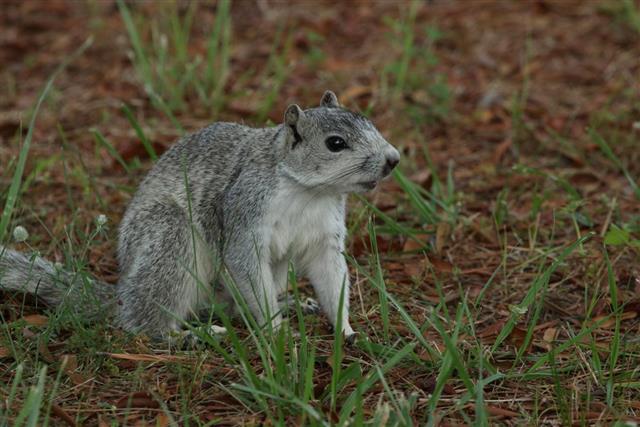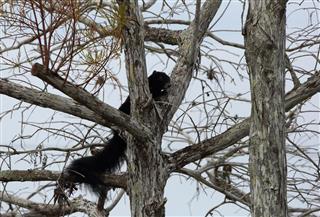
A compilation of some fox squirrel facts intended to introduce you to a species which is known for its gregarious and playful nature. Now these are some qualities which you seldom associate with animals in wilderness, but fox squirrel seems to be an exception.
The fox squirrel (Sciurus niger) – also referred to as the eastern fox squirrel or the Bryant’s fox squirrel, is a species of squirrel native to North America. The species boasts of being the largest tree squirrel species native to the continent. While their large size is indeed quite fascinating, there exist several other facts about this species which the layman is not quite aware of. The fox squirrel is often mistaken for the red squirrel or gray squirrel species with whom it shares its natural habitat in the wild, and this goof up can be attributed to the very ignorance about some of the basic facts about this species.
Facts about the Fox Squirrel Species
Even though the fox squirrel happens to be a tree dwelling squirrel species, it is known to spend a considerable amount of time on ground. Other than their amazing ability to climb the trees, fox squirrels are also known for their ability to free fall from a height of as much as 20 ft with relative ease – and safely landing on the trunk of the tree.
These squirrels are agile jumpers as well, and have the amazing ability of covering several feet with a single jump. They are diurnal in nature i.e., active during the day. Even though they don’t indulge in territorial behavior, they are known to leave scents to communicate with each other. More of such facts – with reference to its sub-species, range, habitat, diet, etc., are discussed below.
Colloquial Names and Sub-Species
The fox squirrel is also known by several different names in its native habitat; with names like the stump-eared squirrel, raccoon squirrel and monkey-faced squirrel being quite popular among masses. There exist as many as ten sub-species of the fox squirrel on the planet, and they are:
- Southern fox squirrel (Sciurus niger niger)
- Big Cypress fox squirrel (Sciurus niger avicinnia)
- Upland fox squirrel (Sciurus niger bachmani)
- Delmarva fox squirrel (Sciurus niger cinereus)
- Texas fox squirrel (Sciurus niger limitis)
- Pineywoods fox squirrel (Sciurus niger ludovicianus)
- Western fox squirrel (Sciurus niger rufiventer)
- Sherman’s fox squirrel (Sciurus niger shermani)
- Delta fox squirrel (Sciurus niger subauratus)
- Eastern fox squirrel (Sciurus niger vulpinus)
Geographical Range and Natural Habitat
The geographical range of the fox squirrel species spans across the eastern and central United States, right into the southern prairie provinces of Canada. Of late, it has also been introduced into other parts of the country – and the state of California is perhaps the best example of this. Even though the natural habitat of this squirrel spans different types of forests (as well as residential areas), the species seems to prefer open-woodlands – devoid of dense canopy layer, within its geographical range.
Size and Appearance
With its average length ranging between 17.7 to 27.6 inches – excluding the length of its tail which is somewhere around 7.9 to 13.0 inches, and weight of around 1.1 to 2.2 lb, the fox squirrel is indeed the largest tree squirrel species in North America. Their coat color depends on their geographical range. While brown-grey and brown-yellow combinations are the most common color patterns in this species, the eastern population is typically characterized by brown or black coat with white bands on its face and southern population by uniform black coats.
Dietary Habits
The species is carnivorous in nature and feeds on a range of plant products – right from tree buds and bulbs to nuts and roots, small insects and eggs of birds. As with its appearance, the dietary habits of the fox squirrel are also determined by it geographical range – and availability of food. While hickories make up a major portion of their diet in Illinois, the same is replaced by horse-apple and seeds of Kentucky coffee tree in Kansas and acorns in Texas. In some regions, their diet changes according to season as certain foods are not available at a particular time of the year.
Reproductive Behavior
Fox squirrels typically attain sexual maturity at the age of 10-11 months, and usually produce two litters a year. The gestation period for this species extends to 44 – 45 days, at the end of which the female gives birth to a litter of, on an average, three young ones. These squirrels reside in leaf nests in summer and shift to tree dens (i.e., tree cavities) during the winter season where litter rearing takes place.
Born blind, deaf and without fur, the young ones of fox squirrel open their eyes by fourth or fifth week of birth and ears by sixth week of birth. The weaning period in this species may extend to the tenth week at the max, but the young ones continue to be dependent on their mother for up to 12 weeks from birth.
Even though the average lifespan of a fox squirrel in captivity is 18 years, the same in wild seldom extends 12 years. This difference in their mortality rate can be attributed to the number of predators on this species in the wild as well as habitat loss caused as a result of large-scale deforestation. While the species is trying to get accustomed to urban environment, the task is not quite easy with domestic cats and dogs turning out to be as hazardous for these squirrels as their predators in the wilderness.






